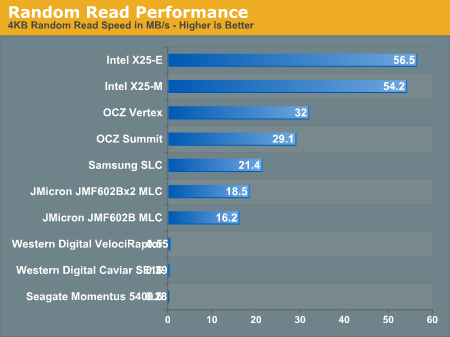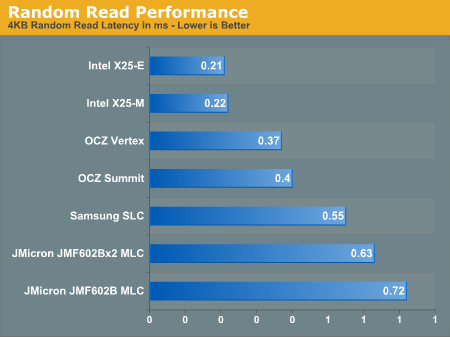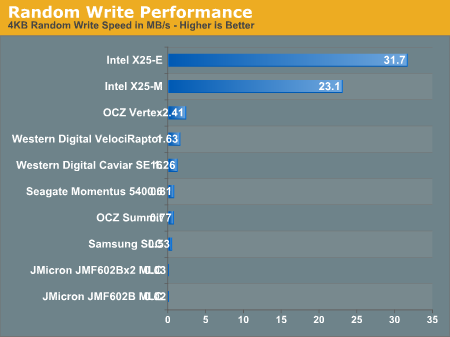The SSD Anthology: Understanding SSDs and New Drives from OCZ
by Anand Lal Shimpi on March 18, 2009 12:00 AM EST- Posted in
- Storage
Random Read/Write Performance
Arguably much more important to any PC user than sequential read/write performance is random access performance. It's not often that you're writing large files sequentially to your disk, but you do encounter tons of small file reads/writes as you use your PC.
To measure random read/write performance I created an iometer script that peppered the drive with random requests, with an IO queue depth of 3 (to add some multitasking spice to the test). The write test was performed over an 8GB range on the drive, while the read test was performed across the whole drive. I ran the test for 3 minutes.

The three hard drives all posted scores below 1MB/s and thus aren't visible on our graph above. This is where SSDs shine and no hard drive, regardless of how many you RAID together, can come close.
The two Intel drives top the charts and maintain a huge lead. The OCZ Vertex actually beats out the more expensive (and unreleased) Summit drive with a respectable 32MB/s transfer rate here. Note that the Vertex is also faster than last year's Samsung SLC drive that everyone was selling for $1000. Even the JMicron drives do just fine here.
If we look at latency instead of transfer rate it helps put things in perspective:

Read latencies for hard drives have always been measured in several ms, but every single SSD here manages to complete random reads in less than 1ms under load.
Random write speed is where we can thin the SSD flock:

Only the Intel drives and to an extent, the OCZ Vertex, post numbers visible on this scale. Let's go to a table to see everything in greater detail:
| 4KB Random Write Speed | |
| Intel X25-E | 31.7 MB/s |
| Intel X25-M | 23.1 MB/s |
| JMicron JMF602B MLC | 0.02 MB/s |
| JMicron JMF602Bx2 MLC | 0.03 MB/s |
| OCZ Summit | 0.77 MB/s |
| OCZ Vertex | 2.41 MB/s |
| Samsung SLC | 0.53 MB/s |
| Seagate Momentus 5400.6 | 0.81 MB/s |
| Western Digital Caviar SE16 | 1.26 MB/s |
| Western Digital VelociRaptor | 1.63 MB/s |
Every single drive other than the Intel X25-E, X25-M and OCZ's Vertex is slower than the 2.5" Seagate Momentus 5400.6 hard drive in this test. The Vertex, thanks to OCZ's tweaks, is now 48% faster than the VelociRaptor.
The Intel drives are of course architected for the type of performance needed on a desktop/notebook and thus they deliver very high random write performance.
Random write performance is merely one corner of the performance world. A drive needs good sequential read, sequential write, random read and random write performance. The fatal mistake is that most vendors ignore random write performance and simply try to post the best sequential read/write speeds; doing so simply produces a drive that's undesirable.
While the Vertex is slower than Intel's X25-M, it's also about half the price per GB. And note that the Vertex is still 48% faster than the VelociRaptor here, and multiple times faster in the other tests.










250 Comments
View All Comments
zdzichu - Sunday, March 22, 2009 - link
Very nice and thorough article. I only lack more current status of TRIM command support in current operating systems. For example, Linux supports it since last year:http://kernelnewbies.org/Linux_2_6_28#head-a1a9591...">http://kernelnewbies.org/Linux_2_6_28#h...a9591f48...
Sinned - Sunday, March 22, 2009 - link
Outstanding article that really helped me understand SSD drives. I wonder how much of an impact the new SATA III standard will have on SSD drives? I believe we are still at the beginning stage for SSD drives and your article shows that much more work needs to be done. My respect for OCZ and how they responded in a positive and productive way should be a model for the rest of the SSD makers. Thank you again for such a concise article.Respectfully,
Sinned
529th - Sunday, March 22, 2009 - link
The first thing I thought of was Democracy. Don't know why. Maybe it was because a company listened to our common goal of performance. Thank you OCZ for listening, I'm sure it will pay off!!!araczynski - Saturday, March 21, 2009 - link
very nice read. the 4/512 issue seems a rather stupid design decision, or perhaps more likely a stupid problem to find this 4/512 solution as 'acceptable'.although a great marketing choice, built in automatic life expectancy reduction.
sounds like the manufacturers want the hard drives to become a disposable medium like styrofoam cups.
perhaps when they narrow the disparity down to 4/16, i might consider buying an ssd. that, or when they beat the 'old school' physical platters in price.
until then, get back to the drawing board and stop crapping out these half arsed 'should be good enough' solutions.
IntelUser2000 - Sunday, March 22, 2009 - link
araczynski: The 4/512 isn't done by accident. It's done to lower prices. The flash technology used in SSDs are meant to replace platter HDDs in the future. There's no way of doing that without cost reductions like these. Even with that the SSDs still cost several times more per storage space.araczynski - Tuesday, March 24, 2009 - link
i understand that, but i don't remember original hard drives being released and being slower than the floppy drives they were replacing.this is part of the 'release beta' products mentality and make the consumer pay for further development.
the 5.25" floppy was better than the huge floppy in all respects when it was released. the 3.5" floppy was better than the 5.25" floppy when it was released. the usb flash drives were better than the 3.5" floppies when they were released.
i just hate the way this is being played out at the consumer's expense.
hellcats - Saturday, March 21, 2009 - link
Anand,What a great article. I usually have to skip forwards when things bog down, but they never did with this long, but very informative article. Your focus on what matters to users is why I always check anandtech first thing every morning.
juraj - Saturday, March 21, 2009 - link
I'm curious what capacity is the OCZ Vertex drive reviewed. Is it an 120 / 250g drive or supposedly slower 30 / 60g one?Symbolics - Friday, March 20, 2009 - link
The method for generating "used" drives is flawed. For creating a true used drive, the spare blocks must be filled as well. Since this was not done, the results are biased towards the Intel drives with their generous amount of spare blocks that were *not* exhausted when producing the used state. An additional bias is introduced by the reduction of the IOmeter write test to 8 GB only. Perhaps there are enough spare blocks on the Intel drives so that these 8 GB can be written to "fresh" blocks without the need for (time-consuming) erase operations.Apart from these concerns, I enjoyed reading the article.
unknownError - Saturday, March 21, 2009 - link
I also just created an account to post, very nice article!Lots of good well thought out information, I'm so tired of synthetic benchmarks glad someone goes through the trouble to bench these things right (and appears to have the education to really understand them). Whats with the grammar police though? geez...